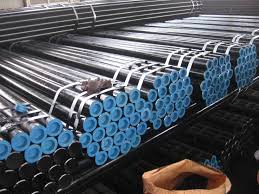The people who have been in the business of manufacturing seamless tubes will be well aware of the primitive technology of rolling mill, used widely in the nineteenth century. This technique was used to produce seamless pipes and tubes to be used in industries. The whole procedure is long and included the following steps:
- With the use of funnel rolls, rolled sheets are converted into a cross-sectional circle
- Through the welding process, the lap welding was carried out on these cross-sectional circle
This all seems to have changed now, thankfully because of the advent of new technological advancements and developments. Due to this, many new processes have surfaced that makes the whole manufacturing process of seamless tubes, easy and cost-effective. But the most popular process that has caught on with many manufacturers in the process of continuous tube mill. No forge welding or filler metal is used in this new technique.
Seamless Tube Manufacturing Process
1. Preparing the stainless steel sheets
The stainless steel sheets undergo several checks before getting picked to roll. While preparing them, the first step is to trim them around the edges.
2. Rolling through rollers
The sheets are then passed through many rollers to match the required size. In this step, you can see the sheets progressing into tubular shapes.
3. Rollers Through the fitted welding machine
In this step, the tubular shape has to go through a fitted welding machine. The inside of these tubular shapes, i.e., the weld beads and scraps are removed, thus giving you perfectly rolled tubes.
4. Cleaning and heating of rolled seamless tubes
After the stainless sheets have a basic rolled structure, it goes through the process of cleaning and heating. This depends upon the clients’ requirements. The stainless steel tubes are cleaned thoroughly to remove dirt before the heating process begins. Heating is used to remove the possible stress on the seamless tubes and let it have a seamless shape. The tubular shape is rolled in a hot furnace that has temperature controllers and recorders. The heating process helps the tubes to be straightened and open to pickling and removing the scales from its surface.
5. The cold-drawing process
Many clients have a peculiar tube requirement that will not match the seamless tubes rolled out directly from the mills. For this reason, another process of cold-drawing is to be performed to achieve the desired size.
To manufacture cold-drawn seamless tubes, the manufacturer first coats the tube with soap and oxalic solution. The solution helps to reduce the friction caused due to this process, by acting as a lubricant. Later, the seamless tubes are benched with the help of Die plugs.
6. Final touches
The final touches include ink jet marking on the seamless tubes, that educates the exporters about the tube’s grade, material, heat number, size, and a third party inspection stamp. Followed right after this are several stringent quality checks and appropriate packaging, making these seamless tubes ready for dispatch.
There are several industries that need seamless tubes in different alloys to have varied tensile strength. Thus many manufacturers produce the alloy steel Seamless tube. The most popular among these alloy steel seamless tubes are a carbon steel seamless tube.
How Can You Improve the Seamless Tubes Manufacturing Process?
Manufacturing seamless tubes is a complex process that requires precision, efficiency, and adherence to strict quality standards. However, with the advent of advanced technologies, there are several ways to enhance the manufacturing process. Let’s explore some key strategies for improvement:
1. Automation and Robotics
Integrating automation and robotics into manufacturing can significantly improve efficiency and precision. Automated systems can handle material handling, tube shaping, welding, and quality control tasks. It can enhance productivity and ensure consistent quality by reducing manual labour and human error.
2. Quality Control Systems
Implementing robust quality control systems is essential for ensuring the integrity of seamless tubes. Advanced inspection technologies, such as automated optical inspection and non-destructive testing methods like ultrasonic or eddy current testing, can detect any tube flaws or defects. These systems enable manufacturers to promptly identify and address issues, improving overall quality and customer satisfaction.
3. Computer-Aided Design and Manufacturing (CAD/CAM)
CAD/CAM systems play a crucial role in seamless tube manufacturing. These software tools enable designers and engineers to create intricate designs and simulate manufacturing. By optimising the design and production parameters, CAD/CAM systems help minimise material waste and streamline production, resulting in improved efficiency and cost-effectiveness.
4. Precision Machining and Finishing
Advanced machining technologies, such as CNC (Computer Numerical Control) machining, allow for the precisely shaping and finishing seamless tubes. CNC machines offer high accuracy, repeatability, and the ability to produce complex tube geometries. This technology ensures tight tolerances, smooth surfaces, and excellent dimensional accuracy, meeting the stringent requirements of various industries.
5. Continuous Seamless Tube Mills
Continuous tube mills have revolutionised the seamless tube manufacturing industry. Unlike traditional methods that involve forging welding or filler metal, these mills eliminate the need for these processes. This technology allows for the continuous production of seamless pipes and tubes, resulting in higher productivity, reduced costs, and improved efficiency.
The Evolution of Seamless Tube Manufacturing Techniques
The manufacturing of seamless tubes has come a long way since the nineteenth century. Traditional techniques, such as rolling mills and lap welding, have been replaced by more advanced and efficient methods. Let’s explore the evolution of manufacturing techniques:
Introduction of Continuous Casting
Continuous casting is a significant development in seamless tube manufacturing. It involves the continuous pouring of molten metal into a water-cooled mould, which solidifies the metal into a continuous billet. This continuous casting process ensures better homogeneity and improved mechanical properties of the tubes.
Piercing and Extrusion
Piercing and extrusion are key processes in seamless tube manufacturing. Piercing involves making a hole in the solid billet, while extrusion uses a mandrel to shape the tube and reduce its diameter. These processes have evolved with advancements in tooling technology, resulting in improved accuracy and surface finish of the seamless tubes.
Development of Advanced Alloys
The evolution of seamless pipe manufacturing also includes the development of advanced alloys. High-performance alloys, such as stainless steel, duplex stainless steel, and nickel alloys, offer superior corrosion resistance, high-temperature strength, and other desirable properties. These alloys have expanded the application range of seamless tubes in various industries, including oil and gas, petrochemicals, and automotive.
Customization in Seamless Tube Manufacturing
The ability to meet diverse requirements is a crucial aspect of seamless tube manufacturing. Customisation plays a significant role in achieving this. Seamless pipes can be customised to meet specific customer requirements. This includes dimensions, tolerances, surface finish, and material composition variations. Manufacturers work closely with customers to understand their needs and deliver tailor-made tubes and pipes that precisely match their application requirements.
Frequently Asked Questions
Q: What are the advantages of using seamless tubes over welded tubes?
A: Seamless tubes offer several advantages over welded tubes. They have superior strength and durability due to the absence of welded joints. They also provide excellent resistance to corrosion and high-temperature environments. Moreover, their smooth internal surface minimises pressure loss and facilitates efficient fluid flow.
Q: Can seamless pipes be customised for specific applications?
A: Yes, pipes and tubes can be customised to meet specific application requirements. Manufacturers can adjust dimensions, tolerances, material composition, and surface finish based on customer needs. Customisation ensures that seamless tubes and pipes are optimised for their intended use and deliver optimal performance.
Q: What industries rely on seamless tubes?
A: Seamless tubes find applications in various industries, including oil and gas, petrochemicals, automotive, aerospace, power generation, and construction. They are commonly used for conveying fluids, gases, and steam in critical environments where reliability, strength, and corrosion resistance are paramount.
Q: What are the key quality control measures in tube manufacturing?
A: Quality control measures in seamless tube manufacturing include rigorous inspection of raw materials, in-process monitoring, dimensional checks, non-destructive testing methods (such as ultrasonic or eddy current testing), and visual inspection. These measures ensure seamless tubes meet the required specifications and adhere to stringent quality standards.
Q: How is the cold-drawing process beneficial for seamless tubes?
A: The cold-drawing process enhances the dimensional accuracy, mechanical properties, and surface finish of the tubes. It allows for precise size reduction, resulting in tubes with tight tolerances and improved strength. Additionally, cold drawing imparts a smooth surface finish, making the tubes suitable for various high-performance applications.
If you are confused as to which one will suit your business, then don’t be. Just call Anand Seamless Ltd and let us help you to have custom seamless tubes, ideal for your business. Call us at +91-9099996851 or drop us a mail on inquiry@anandseamless.com to know more about our seamless tubes. Get in touch now!


